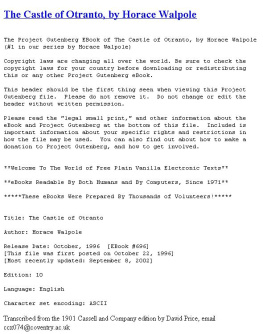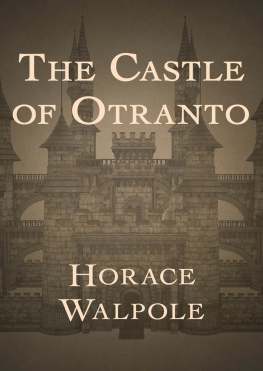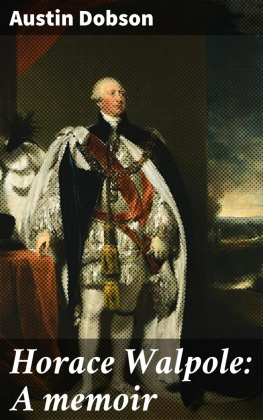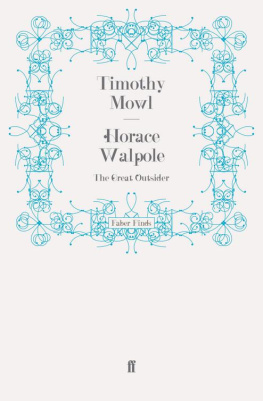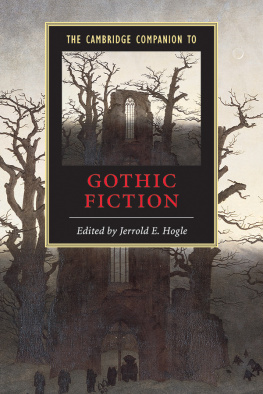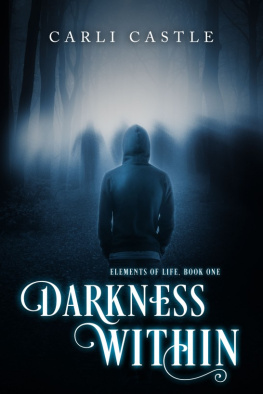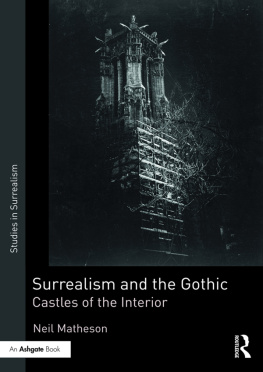Walpole - The castle of Otranto: a Gothic story
Here you can read online Walpole - The castle of Otranto: a Gothic story full text of the book (entire story) in english for free. Download pdf and epub, get meaning, cover and reviews about this ebook. year: 1854, publisher: H.C. Baird, genre: Art. Description of the work, (preface) as well as reviews are available. Best literature library LitArk.com created for fans of good reading and offers a wide selection of genres:
Romance novel
Science fiction
Adventure
Detective
Science
History
Home and family
Prose
Art
Politics
Computer
Non-fiction
Religion
Business
Children
Humor
Choose a favorite category and find really read worthwhile books. Enjoy immersion in the world of imagination, feel the emotions of the characters or learn something new for yourself, make an fascinating discovery.
The castle of Otranto: a Gothic story: summary, description and annotation
We offer to read an annotation, description, summary or preface (depends on what the author of the book "The castle of Otranto: a Gothic story" wrote himself). If you haven't found the necessary information about the book — write in the comments, we will try to find it.
Walpole: author's other books
Who wrote The castle of Otranto: a Gothic story? Find out the surname, the name of the author of the book and a list of all author's works by series.
The castle of Otranto: a Gothic story — read online for free the complete book (whole text) full work
Below is the text of the book, divided by pages. System saving the place of the last page read, allows you to conveniently read the book "The castle of Otranto: a Gothic story" online for free, without having to search again every time where you left off. Put a bookmark, and you can go to the page where you finished reading at any time.
Font size:
Interval:
Bookmark:
Transcribed from the 1901 Cassell andCompany edition by David Price, email ccx074@coventry.ac.uk
THE CASTLE OF OTRANTO
PREFACE TO THE FIRST EDITION.
The following work was found in the library of an ancient Catholicfamily in the north of England. It was printed at Naples, inthe black letter, in the year 1529. How much sooner it waswritten does not appear. The principal incidents are such aswere believed in the darkest ages of Christianity; but the languageand conduct have nothing that savours of barbarism. The styleis the purest Italian.
If the story was written near the time when it is supposed to havehappened, it must have been between 1095, the era of the firstCrusade, and 1243, the date of the last, or not longafterwards. There is no other circumstance in the work thatcan lead us to guess at the period in which the scene is laid: thenames of the actors are evidently fictitious, and probablydisguised on purpose: yet the Spanish names of the domestics seemto indicate that this work was not composed until the establishmentof the Arragonian Kings in Naples had made Spanish appellationsfamiliar in that country. The beauty of the diction, and thezeal of the author (moderated, however, by singular judgment)concur to make me think that the date of the composition was littleantecedent to that of the impression. Letters were then intheir most flourishing state in Italy, and contributed to dispelthe empire of superstition, at that time so forcibly attacked bythe reformers. It is not unlikely that an artful priest mightendeavour to turn their own arms on the innovators, and might availhimself of his abilities as an author to confirm the populace intheir ancient errors and superstitions. If this was his view,he has certainly acted with signal address. Such a work asthe following would enslave a hundred vulgar minds beyond half thebooks of controversy that have been written from the days of Lutherto the present hour.
This solution of the authors motives is, however, offered as amere conjecture. Whatever his views were, or whatever effectsthe execution of them might have, his work can only be laid beforethe public at present as a matter of entertainment. Even assuch, some apology for it is necessary. Miracles, visions,necromancy, dreams, and other preternatural events, are explodednow even from romances. That was not the case when our authorwrote; much less when the story itself is supposed to havehappened. Belief in every kind of prodigy was so establishedin those dark ages, that an author would not be faithful to themanners of the times, who should omit all mention of them. Heis not bound to believe them himself, but he must represent hisactors as believing them.
If this air of the miraculous is excused, the reader will findnothing else unworthy of his perusal. Allow the possibilityof the facts, and all the actors comport themselves as personswould do in their situation. There is no bombast, no similes,flowers, digressions, or unnecessary descriptions. Everythingtends directly to the catastrophe. Never is the readersattention relaxed. The rules of the drama are almost observedthroughout the conduct of the piece. The characters are welldrawn, and still better maintained. Terror, the authorsprincipal engine, prevents the story from ever languishing; and itis so often contrasted by pity, that the mind is kept up in aconstant vicissitude of interesting passions.
Some persons may perhaps think the characters of the domestics toolittle serious for the general cast of the story; but besides theiropposition to the principal personages, the art of the author isvery observable in his conduct of the subalterns. Theydiscover many passages essential to the story, which could not bewell brought to light but by their navet andsimplicity. In particular, the womanish terror and foibles ofBianca, in the last chapter, conduce essentially towards advancingthe catastrophe.
It is natural for a translator to be prejudiced in favour of hisadopted work. More impartial readers may not be so muchstruck with the beauties of this piece as I was. Yet I am notblind to my authors defects. I could wish he had groundedhis plan on a more useful moral than this: that the sins offathers are visited on their children to the third and fourthgeneration. I doubt whether, in his time, any more than atpresent, ambition curbed its appetite of dominion from the dread ofso remote a punishment. And yet this moral is weakened bythat less direct insinuation, that even such anathema may bediverted by devotion to St. Nicholas. Here the interest ofthe Monk plainly gets the better of the judgment of theauthor. However, with all its faults, I have no doubt but theEnglish reader will be pleased with a sight of thisperformance. The piety that reigns throughout, the lessons ofvirtue that are inculcated, and the rigid purity of the sentiments,exempt this work from the censure to which romances are but tooliable. Should it meet with the success I hope for, I may beencouraged to reprint the original Italian, though it will tend todepreciate my own labour. Our language falls far short of thecharms of the Italian, both for variety and harmony. Thelatter is peculiarly excellent for simple narrative. It isdifficult in English to relate without falling too low or risingtoo high; a fault obviously occasioned by the little care taken tospeak pure language in common conversation. Every Italian orFrenchman of any rank piques himself on speaking his own tonguecorrectly and with choice. I cannot flatter myself withhaving done justice to my author in this respect: his style is aselegant as his conduct of the passions is masterly. It is apity that he did not apply his talents to what they were evidentlyproper for - the theatre.
I will detain the reader no longer, but to make one shortremark. Though the machinery is invention, and the names ofthe actors imaginary, I cannot but believe that the groundwork ofthe story is founded on truth. The scene is undoubtedly laidin some real castle. The author seems frequently, withoutdesign, to describe particular parts. The chamber, says he,on the right hand; the door on the left hand; the distancefrom the chapel to Conrads apartment: these and other passagesare strong presumptions that the author had some certain buildingin his eye. Curious persons, who have leisure to employ insuch researches, may possibly discover in the Italian writers thefoundation on which our author has built. If a catastrophe,at all resembling that which he describes, is believed to havegiven rise to this work, it will contribute to interest the reader,and will make the Castle of Otranto a still more movingstory.
SONNET TO THE RIGHT HONOURABLE LADY MARY COKE.
The gentle maid, whose hapless tale
Font size:
Interval:
Bookmark:
Similar books «The castle of Otranto: a Gothic story»
Look at similar books to The castle of Otranto: a Gothic story. We have selected literature similar in name and meaning in the hope of providing readers with more options to find new, interesting, not yet read works.
Discussion, reviews of the book The castle of Otranto: a Gothic story and just readers' own opinions. Leave your comments, write what you think about the work, its meaning or the main characters. Specify what exactly you liked and what you didn't like, and why you think so.

